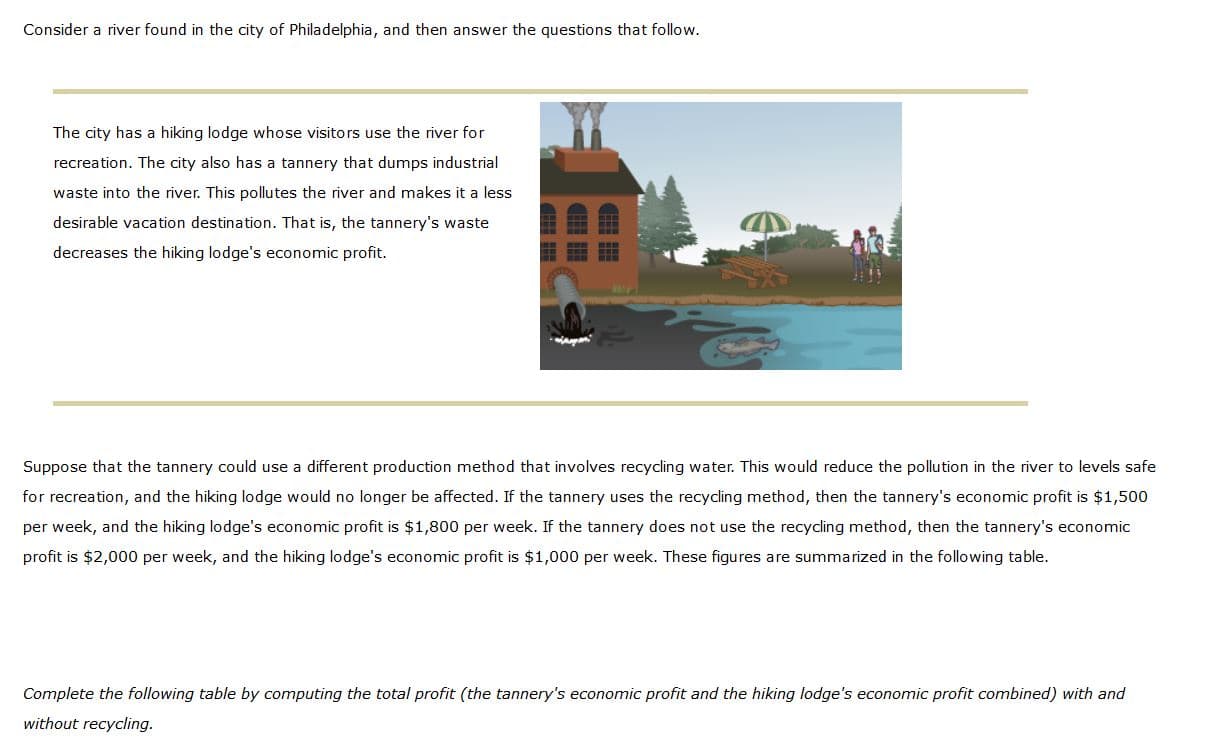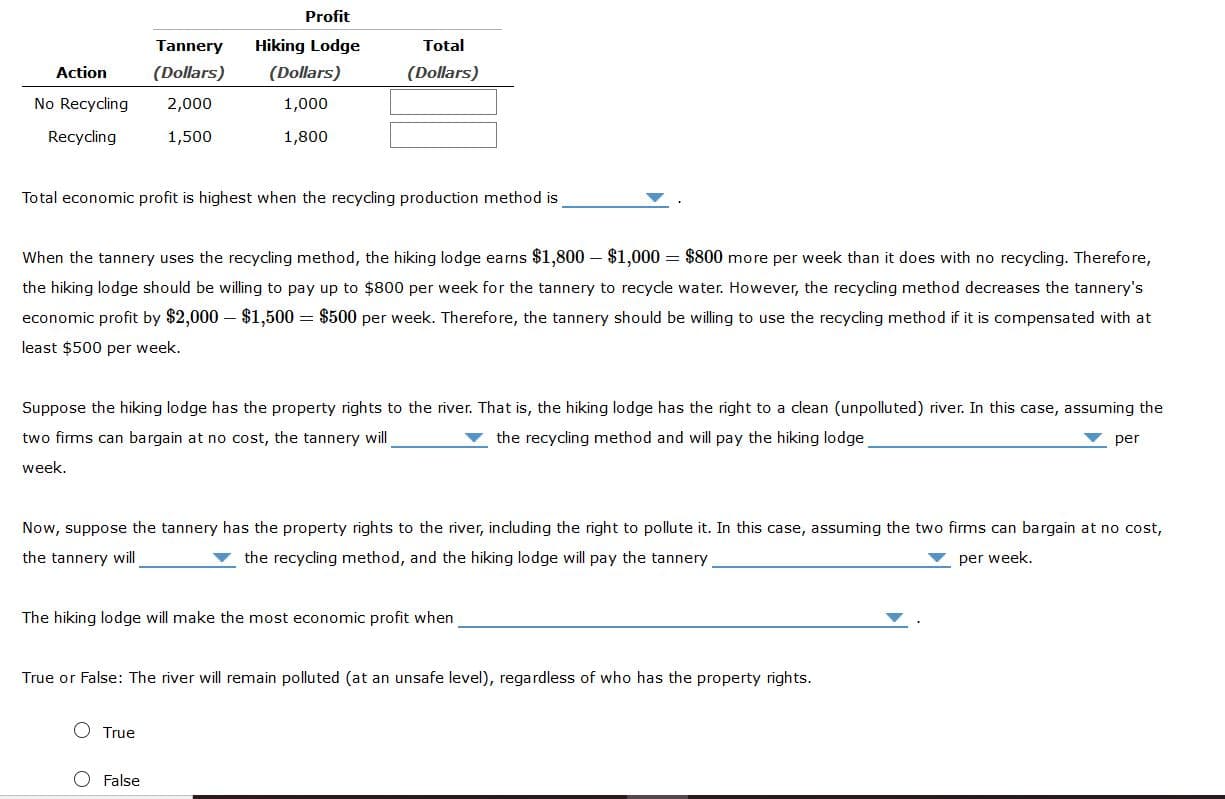Consider a river found in the city of Philadelphia, and then answer the questions that follow. The city has a hiking lodge whose visitors use the river for recreation. The city also has a tannery that dumps industrial waste into the river. This pollutes the river and makes it a less desirable vacation destination. That is, the tannery's waste decreases the hiking lodge's economic profit. Suppose that the tannery could use a different production method that involves recycling water. This would reduce the pollution in the river to levels safe for recreation, and the hiking lodge would no longer be affected. If the tannery uses the recycling method, then the tannery's economic profit is $1,500 per week, and the hiking lodge's economic profit is $1,800 per week. If the tannery does not use the recycling method, then the tannery's economic profit is $2,000 per week, and the hiking lodge's economic profit is $1,000 per week. These figures are summarized in the following table. Complete the following table by computing the total profit (the tannery's economic profit and the hiking lodge's economic profit combined) with and without recycling. Profit Tannery Hiking Lodge Total Action (Dollars) (Dollars) (Dollars) No Recycling 2,000 1,000 Recycling 1,500 1,800 Total economic profit is highest when the recycling production method is When the tannery uses the recycling method, the hiking lodge earns $1,800 – $1,000 = $800 more per week than it does with no recycling. Therefore, the hiking lodge should be willing to pay up to $800 per week for the tannery to recycle water. However, the recycling method decreases the tannery's economic profit by $2,000 – $1,500 = $500 per week. Therefore, the tannery should be willing to use the recycling method if it is compensated with at least $500 per week. Suppose the hiking lodge has the property rights to the river. That is, the hiking lodge has the right to a clean (unpolluted) river. In this case, assuming the two firms can bargain at no cost, the tannery will the recycling method and will pay the hiking lodge v per week. Now, suppose the tannery has the property rights to the river, including the right to pollute it. In this case, assuming the two firms can bargain at no cost, the tannery will the recycling method, and the hiking lodge will pay the tannery per week. The hiking lodge will make the most economic profit when True or False: The river will remain polluted (at an unsafe level), regardless of who has the property rights. O True O False
Consider a river found in the city of Philadelphia, and then answer the questions that follow. The city has a hiking lodge whose visitors use the river for recreation. The city also has a tannery that dumps industrial waste into the river. This pollutes the river and makes it a less desirable vacation destination. That is, the tannery's waste decreases the hiking lodge's economic profit. Suppose that the tannery could use a different production method that involves recycling water. This would reduce the pollution in the river to levels safe for recreation, and the hiking lodge would no longer be affected. If the tannery uses the recycling method, then the tannery's economic profit is $1,500 per week, and the hiking lodge's economic profit is $1,800 per week. If the tannery does not use the recycling method, then the tannery's economic profit is $2,000 per week, and the hiking lodge's economic profit is $1,000 per week. These figures are summarized in the following table. Complete the following table by computing the total profit (the tannery's economic profit and the hiking lodge's economic profit combined) with and without recycling. Profit Tannery Hiking Lodge Total Action (Dollars) (Dollars) (Dollars) No Recycling 2,000 1,000 Recycling 1,500 1,800 Total economic profit is highest when the recycling production method is When the tannery uses the recycling method, the hiking lodge earns $1,800 – $1,000 = $800 more per week than it does with no recycling. Therefore, the hiking lodge should be willing to pay up to $800 per week for the tannery to recycle water. However, the recycling method decreases the tannery's economic profit by $2,000 – $1,500 = $500 per week. Therefore, the tannery should be willing to use the recycling method if it is compensated with at least $500 per week. Suppose the hiking lodge has the property rights to the river. That is, the hiking lodge has the right to a clean (unpolluted) river. In this case, assuming the two firms can bargain at no cost, the tannery will the recycling method and will pay the hiking lodge v per week. Now, suppose the tannery has the property rights to the river, including the right to pollute it. In this case, assuming the two firms can bargain at no cost, the tannery will the recycling method, and the hiking lodge will pay the tannery per week. The hiking lodge will make the most economic profit when True or False: The river will remain polluted (at an unsafe level), regardless of who has the property rights. O True O False
Principles of Economics 2e
2nd Edition
ISBN:9781947172364
Author:Steven A. Greenlaw; David Shapiro
Publisher:Steven A. Greenlaw; David Shapiro
Chapter13: Positive Externalities And Public Goods
Section: Chapter Questions
Problem 23P: HighFlyer Airlines wants to build new airplanes with greatly increased cabin space. This will allow...
Related questions
Question
100%
Consider a river found in the city of Philadelphia, and then answer the questions that follow.

Transcribed Image Text:Consider a river found in the city of Philadelphia, and then answer the questions that follow.
The city has a hiking lodge whose visitors use the river for
recreation. The city also has a tannery that dumps industrial
waste into the river. This pollutes the river and makes it a less
desirable vacation destination. That is, the tannery's waste
decreases the hiking lodge's economic profit.
Suppose that the tannery could use a different production method that involves recycling water. This would reduce the pollution in the river to levels safe
for recreation, and the hiking lodge would no longer be affected. If the tannery uses the recycling method, then the tannery's economic profit is $1,500
per week, and the hiking lodge's economic profit is $1,800 per week. If the tannery does not use the recycling method, then the tannery's economic
profit is $2,000 per week, and the hiking lodge's economic profit is $1,000 per week. These figures are summarized in the following table.
Complete the following table by computing the total profit (the tannery's economic profit and the hiking lodge's economic profit combined) with and
without recycling.

Transcribed Image Text:Profit
Tannery
Hiking Lodge
Total
Action
(Dollars)
(Dollars)
(Dollars)
No Recycling
2,000
1,000
Recycling
1,500
1,800
Total economic profit is highest when the recycling production method is
When the tannery uses the recycling method, the hiking lodge earns $1,800 – $1,000 = $800 more per week than it does with no recycling. Therefore,
the hiking lodge should be willing to pay up to $800 per week for the tannery to recycle water. However, the recycling method decreases the tannery's
economic profit by $2,000 – $1,500 = $500 per week. Therefore, the tannery should be willing to use the recycling method if it is compensated with at
least $500 per week.
Suppose the hiking lodge has the property rights to the river. That is, the hiking lodge has the right to a clean (unpolluted) river. In this case, assuming the
two firms can bargain at no cost, the tannery will
the recycling method and will pay the hiking lodge
v per
week.
Now, suppose the tannery has the property rights to the river, including the right to pollute it. In this case, assuming the two firms can bargain at no cost,
the tannery will
the recycling method, and the hiking lodge will pay the tannery
per week.
The hiking lodge will make the most economic profit when
True or False: The river will remain polluted (at an unsafe level), regardless of who has the property rights.
O True
O False
Expert Solution
This question has been solved!
Explore an expertly crafted, step-by-step solution for a thorough understanding of key concepts.
This is a popular solution!
Trending now
This is a popular solution!
Step by step
Solved in 6 steps with 3 images

Knowledge Booster
Learn more about
Need a deep-dive on the concept behind this application? Look no further. Learn more about this topic, economics and related others by exploring similar questions and additional content below.Recommended textbooks for you

Principles of Economics 2e
Economics
ISBN:
9781947172364
Author:
Steven A. Greenlaw; David Shapiro
Publisher:
OpenStax

Essentials of Economics (MindTap Course List)
Economics
ISBN:
9781337091992
Author:
N. Gregory Mankiw
Publisher:
Cengage Learning

Microeconomics: Private and Public Choice (MindTa…
Economics
ISBN:
9781305506893
Author:
James D. Gwartney, Richard L. Stroup, Russell S. Sobel, David A. Macpherson
Publisher:
Cengage Learning

Principles of Economics 2e
Economics
ISBN:
9781947172364
Author:
Steven A. Greenlaw; David Shapiro
Publisher:
OpenStax

Essentials of Economics (MindTap Course List)
Economics
ISBN:
9781337091992
Author:
N. Gregory Mankiw
Publisher:
Cengage Learning

Microeconomics: Private and Public Choice (MindTa…
Economics
ISBN:
9781305506893
Author:
James D. Gwartney, Richard L. Stroup, Russell S. Sobel, David A. Macpherson
Publisher:
Cengage Learning

Economics: Private and Public Choice (MindTap Cou…
Economics
ISBN:
9781305506725
Author:
James D. Gwartney, Richard L. Stroup, Russell S. Sobel, David A. Macpherson
Publisher:
Cengage Learning